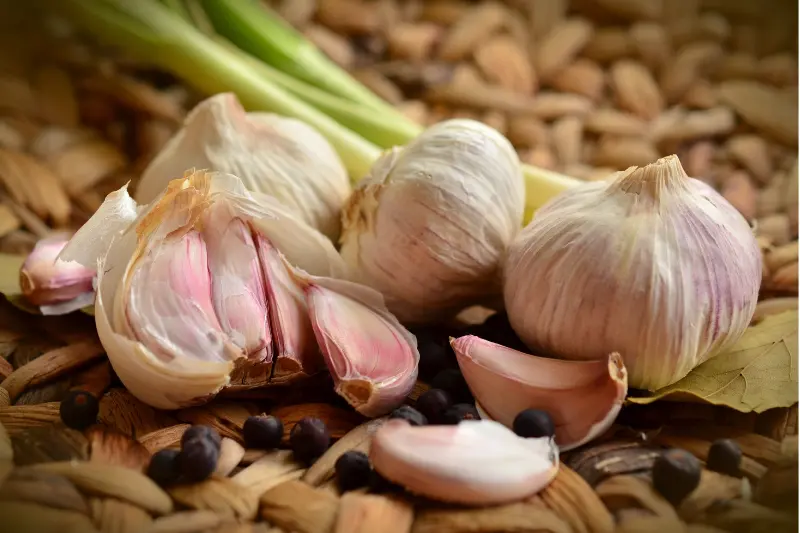WHAT IS GARLIC?
Garlic is classified in the subfamily of leeks and onions. This is where the similar taste comes from, slightly sulfur-like and burningly spicy. Nevertheless, garlic tastes like hearty cuisine and full-bodied dishes.
Garlic has its origins in Central Asia. However, it has always been cultivated all over the world and valued as a spice and medicinal plant.
The plant consists of stem-like leaves above the ground, and the bulb, composed of 15-20 cloves, is hidden underground.
Do you love garlic? Then you can avoid a few mistakes when cooking
For many people, garlic is an integral part of a hearty dish, but not everyone knows that there are a few rules you have to follow. This is the right way.
Garlic is good for your health and is an integral part of many dishes. But how do you use the small, spicy tuber correctly?
Don’t cut the garlic too early
As soon as you have peeled and cut the garlic clove, oxygen reaches the sensitive cut surfaces. The garlic then begins to oxidize and becomes bitter. Therefore, you should cut the tuber quickly and not too long before preparing your meal.
Slice the garlic as evenly as possible
Although it may seem insignificant, it is essential that you cut the garlic into uniform slices or cubes. If you don’t do this, you run the risk of individual pieces of garlic burning before the others are cooked through. If garlic gets too dark, it tastes unpleasantly bitter.
Do not use a garlic press
A garlic press processes garlic quickly and easily into a fine mass. That sounds tempting, as it saves the hassle of chopping the garlic clove. But you have to keep in mind that pressed garlic cloves have a much more aggressive and intense flavor than their finely chopped counterparts. Furthermore, squeezed garlic bulbs burn more quickly, which brings us back to the bitter flavor.
Don’t add the garlic to the dish too early
By now, you may have realized that garlic is much more delicate to prepare than you thought. That’s why it’s a fatal mistake to put the tuber in the pan or pot too early. If you are frying a dish without additional liquid, the garlic should only be added when half of the cooking time is already over. If a liquid portion is added, you don’t have to be quite as strict. As a result, the temperature drops, and the garlic doesn’t burn. When in doubt, it is better to undercook the garlic than overcook it.
Remove the heart.”
Fresh, young garlic has a white, soft heart. You can use this with peace of mind. However, if the garlic has been lying around for a long time, it will sprout. As a result, the heart slowly turns green and woody. If this is the case, you should remove it before cutting. Don’t worry, it can be easily removed.
If you follow these simple tips and rules, dishes with garlic will taste much better.
Why does garlic make you thirsty?
Why does garlic make you thirsty? Well, does he actually do that? Although one or two scientists may have gotten up in the middle of the night to quench their burning thirst caused by garlic consumption, no one has yet researched this, let alone proven it. There are hypotheses: The sharp, sulfur-containing ingredients in garlic may trigger special taste receptor cells and thus influence the feeling of thirst, according to the suspect’s scientist and garlic fan, Eric Block.
The love of garlic divides humanity – and the phenomenon of “after-thirst”, the thirst after eating the strong spice, is similar. Not every garlic consumer knows it, probably because we tolerate the ingredients differently. Some suffer from no side effects after eating garlic, others from dry mouth, still others are thirsty, and very sensitive people even suffer from a hangover, which is very similar to the much more common alcohol poisoning. The “garlic hangover,” as those affected ruefully and lovingly call it, makes life difficult for many garlic lovers—alliophiles.
A GARLIC LOVE
Garlic, I love you! Garlic (and other alliums) are the subject of a book by Eric Block. It is a declaration of love for the hot spice, in which Block looks far beyond the scientific horizon.
“I don’t remember hearing that garlic is supposed to make you thirsty,” writes chemist Eric Block in an email. “But what I actually feel is that I’m thirsty after a meal flavored with garlic.” Block, professor emeritus at the University at Albany, New York, has researched the chemistry of garlic, onions, and other leeks.
For a long time, scientists paid undivided attention to very specific ingredients: the sulfur-containing compounds that give garlic its characteristic smell. Today, we know that sulfur-free, odorless garlic extracts also have a pharmacological effect. But back to the sulfur-containing compounds and one in particular: allicin, a compound that is created when fresh garlic cloves are crushed because ingredients in the garlic react with each other that were previously separated from each other by cell walls. Allicin, just like the substances into which the unstable compound quickly breaks down, acts like a kind of sharp warfare agent, a defense mechanism against attacks that prevents voracious pests that are after the garlic.
So far, so good. But how exactly is garlic supposed to make you thirsty? Eric Block suspects that allicin could activate the acid-sensitive taste receptor cells, or TRCs (taste receptor cells), on the tongue, which in turn triggers the feeling of thirst. “It would be logical if pungent and irritating compounds in particular would make you thirsty, so that the spiciness could be reduced by drinking fluids.” But no one has yet scientifically tested this.
